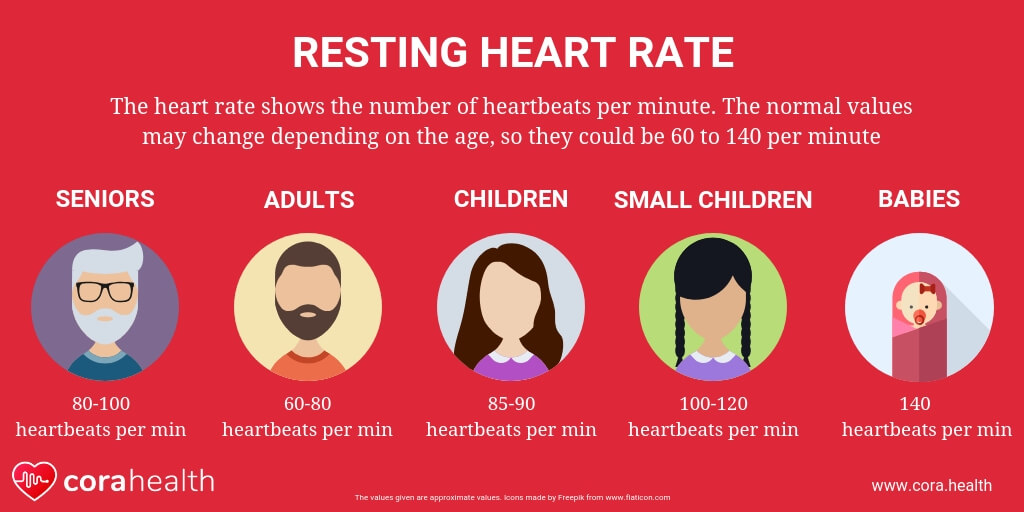In general, a typical adult Resting Heart Rate (RHR) can range between 60-100 beats per minute (BPM). Having a RHR on the higher end of this range is associated with increased health risk.
Your resting heart rate (RHR) can generally be defined as how often your heart beats when you’re at rest. Your heart rate is not static; it changes throughout the day and can vary based on many factors.
Heart rate increases when you exercise, and stress or other environmental variables can also increase heart rate. Heart rate slows when you are calm, sleeping and not moving your body.
Your RHR is only one indicator of health. It should be taken into account with other markers of health including: blood pressure, blood lipids, etc.

Taking as many health measures as possible can give a look into heart and overall health.
Some research has shown a link between your RHR and overall health. In general, a lower RHR may be associated with a lowered risk for cardiovascular disease and even lowered overall mortality.
A higher RHR may indicate lower fitness level and may increase risk for overall mortality.
Generally, people who regularly exercise have a lower RHR compared to people who are sedentary. Therefore, exercising more is an important way to help lower RHR.
How do you know your resting heart rate?

You can easily check your own RHR by taking your pulse from your wrist or neck. Tracking your RHR over time can give you a better sense of what is your normal range for RHR.
You should check your pulse at the same time everyday because your RHR naturally varies throughout the day.
Checking it at the same time everyday will give you a better sense of your range for RHR.
Health experts suggest checking your RHR first thing in the morning before you even get out of bed, have caffeine or exercise.
How to check your pulse
You can check your pulse at your neck or at your wrist. For most people, checking your pulse is easiest at your wrist.
- Simply take your index and middle finger just under the fat pad of your thumb area.
- Gently move your fingers around until you feel the throb of your heart beat.
- Count your pulse for 15 seconds then multiply that number by 4.
You can also take your pulse for 30 seconds and multiply by 2 to get your RHR. Either method will give you your RHR which is based on number of beats per minute.
Resting heart rate and health

Why should you care what your RHR level is?
Having an elevated RHR may be associated with an increased risk for overall mortality. A 2013 study (1) gathered data from 2,798 male adults for 16 years.
Researchers found increasing RHR was associated with all cause mortality independent of physical fitness level.
According to Harvard Health (2), research from a 2010 study with about 129,000 women concluded a lower RHR may offer some protection against having a heart attack.
Why is having a higher RHR an increased risk?
A high RHR means your heart is working harder than normal to move the blood through your body. Over time, this can put extra stress on your heart which can increase risk for a heart attack.
Resting heart rate and physical fitness
/resting-heart-rate-martin-dm-eplus-GettyImages-895081880-5b60b578c9e77c002517b367.jpg)
Exercise is associated with numerous health benefits including: lowering risk for type 2 diabetes, certain cancers, cardiovascular disease, stroke and depression (3).
Aerobic exercise in particular can be beneficial for heart health by strengthening the heart and improving aerobic capacity.
Heart rate increases with exercise because there is a higher demand for blood flow from muscles. Even though heart rate increases during exercise, the overall effect of exercise can translate to a lowered RHR.
As your body adapts to exercise, the heart should grow stronger which means the beating of the heart gets more efficient. This can translate to a lowered RHR. Athletes are known to have a low RHR which could be less than 60 beats per minute.
What should your resting heart rate be?
What is considered a low or high RHR? In general, a typical adult RHR can range between 60-100 beats per minute (BPM).
Having a RHR on the higher end of this range is associated with increased health risk.
A RHR between 80- over 100 has been shown to be associated with increased risk of mortality.
Having a lower RHR, between 60-80 BPM, is generally associated with health benefits. However, there is individual variance for what your RHR should be.
If your RHR is lower than 60 BPM, this may also cause some negative side effects such as dizziness or fatigue. Certain medications or health conditions can influence heart rate.
Keep in mind there is individual variance with heart rate. The suggested ranges for RHR are general. Some people naturally have a higher or lower heart rate.
Therefore, if you are wondering where your RHR should be, speak with your healthcare team.
Stress and resting heart rate

Besides physical fitness, medications and medical conditions, another factor for RHR level is stress. Stress can influence many areas of the body including RHR (4).
Feeling stressed can set off a chain of events in the body initiated by the release of stress hormones. One of the side effects of having these stress hormones released is an increase in breathing, heart rate and blood pressure.
Over time, having these stress hormones constantly elevated may contribute to heart disease and other negative health effects.
If your RHR is elevated and you think stress is a contributing factor, find ways you can incorporate healthy stress management through exercise, healthy diet, adequate sleep and other healthful stress relieving activities.
Conclusion: Resting heart rate and health
Your RHR is one of many indicators of health. Having a higher RHR is associated with increased risk for heart disease and overall mortality.
One of the best ways to lower your RHR range is through exercise.
People who exercise tend to have lower RHR ranges. Exercise can improve heart health and strengthen heart muscles which can lead to lowered heart rate.
Other factors influencing RHR include: stress, medications, medical conditions and other genetic factors.


